Periodontal Disease
What Is Periodontal Disease?
Periodontal disease is a common but serious condition caused by plaque and tartar build-up on your pet’s teeth. It affects the gums and the supporting structures of the teeth, leading to pain, tooth loss, and even organ damage.
Surveys show that 80% of pets over age 3 have some degree of gum disease.
What Causes It?
That “furry” feeling on your teeth after skipping a brush? That’s plaque – a sticky layer made up of oral fluids, proteins, and bacteria from over 300 bacterial species.
If not removed, plaque hardens into tartar as calcium salts from saliva build up. This hardened tartar can’t be brushed off – it requires professional ultrasonic scaling.
Periodontal disease is the result of the immune system responding to plaque bacteria. The response causes inflammation, which along with bacterial toxins and enzymes, leads to gum detachment, bone loss, and loose teeth. This damage allows plaque to spread deeper, worsening the disease.
The two categories of gum disease:
- Gingivitis – inflammation of the gums without gum detachment
- Periodontitis – inflammation with gum detachment and bone recession
Surveys suggest that 4 out of 5 pets over the age of 3 years have some degree of gum disease.! When did you last look inside your pets mouth?
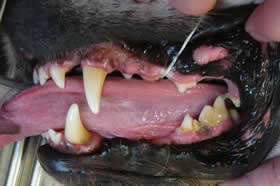
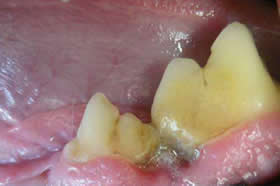

Health Effects
Bad breath is often the first sign owners notice, but it’s usually just the beginning.
As the disease progresses, pets may experience:
- Inflamed, bleeding gums
- Pain when eating
- Dropping food or drooling
- Loose or missing teeth
- Behavioural changes
Each time your pet chews, inflamed gums release bacteria into the bloodstream. This can contribute to inflammatory disease in major organs such as the heart, liver, kidneys, and even the brain.
Diagnosis
Proper diagnosis requires two key steps:
- Periodontal probing
Measures the depth of periodontal pockets. Normal is under 1 mm in cats and under 2 mm in dogs.
- Dental radiographs (X-rays)
Essential for evaluating bone loss and detecting disease below the gumline.
If a dental procedure does not include these steps, disease can easily be missed.
Our Standards at Halifax
- All cat dental procedures include full-mouth dental X-rays.
- For dogs, X-rays are strongly recommended, even if teeth appear normal on visual exam.
- Our digital dental X-ray system delivers high-resolution images quickly and safely.
Dental exams and cleanings are performed under general anaesthesia to ensure thoroughness and safety. Non-anaesthetic dentals are not recommended and may cause more harm than good.
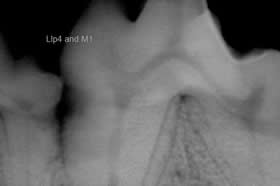
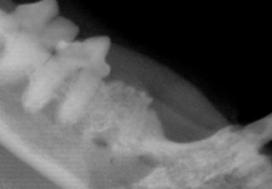
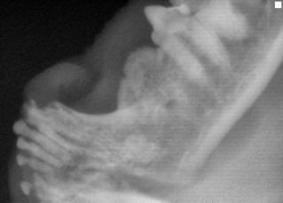
Management and Prevention
Prevention is Key
Daily Brushing
Brushing your pet’s teeth daily or at least every second day is the most effective way to prevent periodontal disease. Start early in life if possible. Many adult pets can also learn to tolerate brushing with the right approach.
Alternatives for Pets Who Won’t Tolerate Brushing
Not all pets accept brushing, especially cats and some small dog breeds. In these cases, other strategies include:
- Dental diets (e.g. Hill’s T/D, Hill’s Oral Care or Royal Canin Dental)
- Dental chews and treats
- Oral gels (e.g. Maxiguard)
- Water additives (e.g. Aquadent Fr3sh)
Because plaque begins to harden within 48-72 hours, these methods need to be used consistently to be effective.
VOHC-Approved Products
The Veterinary Oral Health Council (VOHC) evaluates products for effectiveness in reducing plaque and tartar. Look for the VOHC seal when selecting dental chews, diets, or rinses.
You can find an up-to-date list of accepted products on Veterinary Oral Health Council website.
Book a Dental Check
If your pet hasn’t had a dental exam in the last year, or if you’re concerned about bad breath, bleeding gums, or other signs, contact us to schedule a dental consultation.
